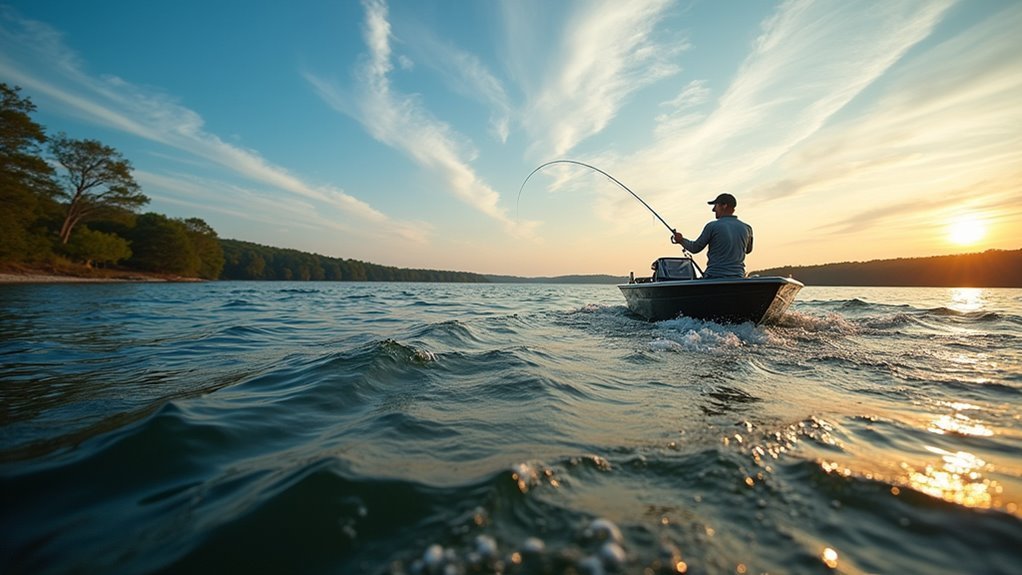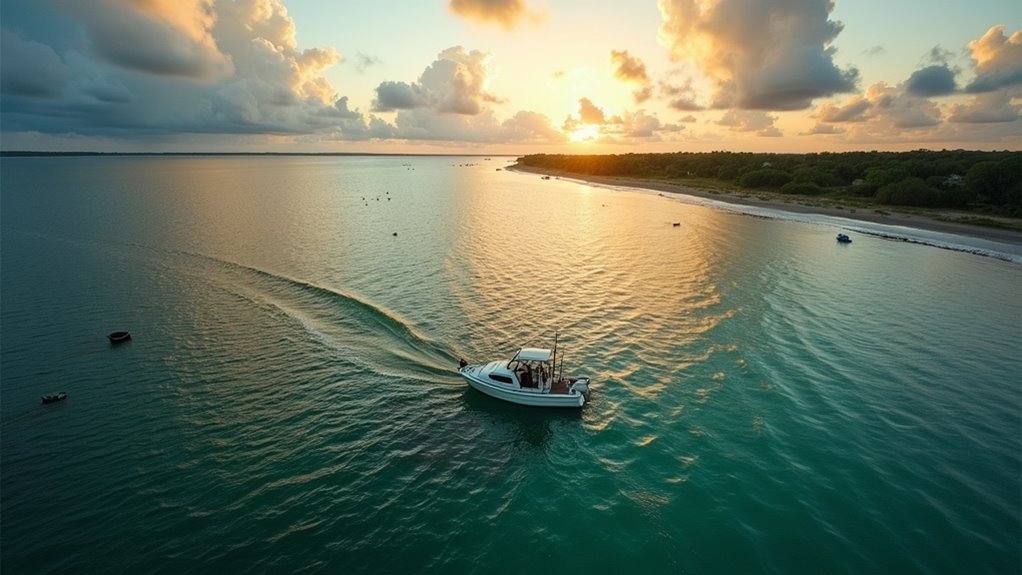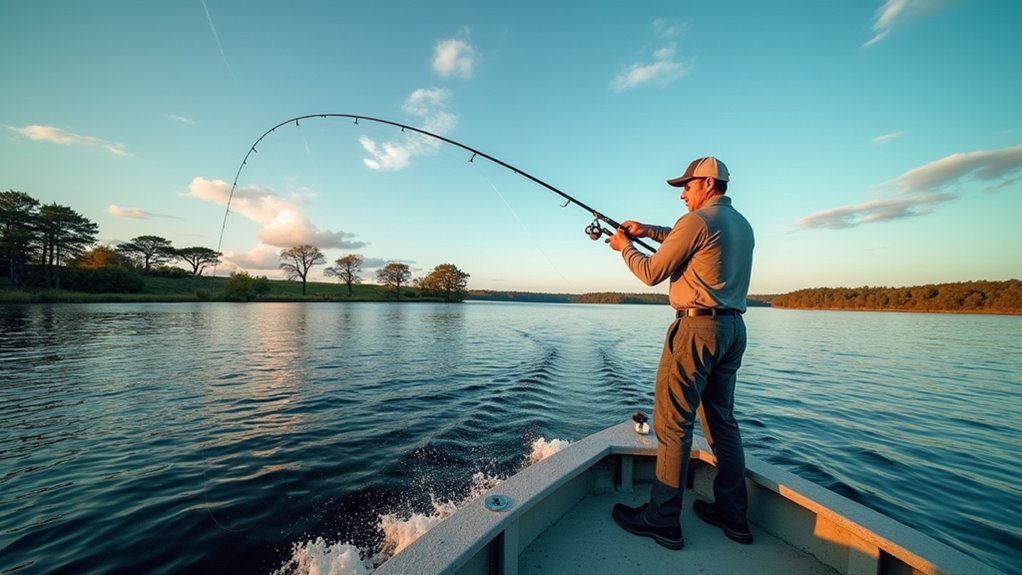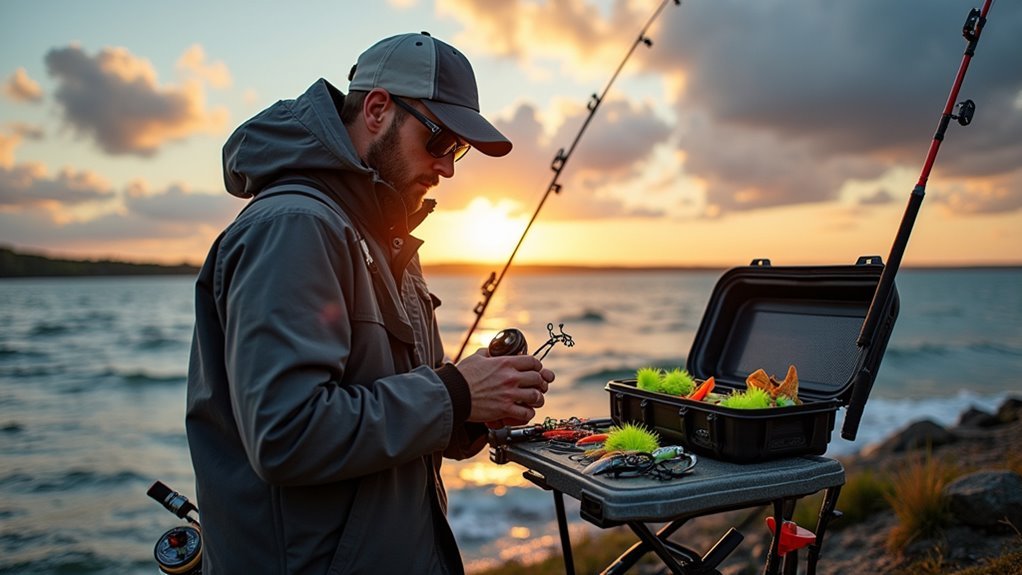Wind can be a fisherman’s secret weapon when used strategically. We’ve found that wind-blown banks and coves are prime fishing spots because they stir up plankton and attract baitfish, which larger predators follow. To harness this power, position yourself where wind creates natural ambush points, use heavier lures when casting into the breeze, and lower your rod tip to reduce resistance. The right equipment—quality anchors and GPS trolling motors—transforms challenging conditions into your advantage. Let’s explore how these tactics can dramatically boost your catch rate.
Understanding Wind Patterns and Fish Behavior

When the wind whispers across the water’s surface, it tells a story that savvy anglers have learned to read. We’ve all noticed how a gentle breeze can transform a lake’s ecosystem in minutes.
Wind stirs up plankton and microparticles, creating a buffet that attracts baitfish. Where there’s bait, there’s bigger fish. It’s that simple.
I’ve spent countless mornings watching wind-blown coves fill with debris and, sure enough, bass follow close behind. Those wind-facing banks? They’re gold mines. Fish position themselves there, ready to ambush disoriented prey swept in by currents.
Strategic Positioning: Finding the Best Wind-Blown Spots

Where should you position your boat when those gusts start picking up? We’ve learned to target wind-blown banks and coves where debris collects. These spots are magnets for baitfish, which naturally attract the bigger predators we’re after.
Points make perfect ambush zones when the wind’s blowing across them. We’ve caught monster bass hanging at these intersections, waiting for an easy meal.
Don’t overlook areas where wind pushes water from drains into the main lake. Last summer, we limited out on crappie in just such a spot when everyone else went home empty-handed.
Adapting Your Casting Technique to Wind Conditions

Mastering your cast becomes essential as soon as those winds kick up on the water. We’ve all been there—fighting against a breeze that seems determined to tangle our lines. When casting into the wind, you’ll need to adjust your technique for success.
Wind challenges separate casual anglers from masters—adapt your cast or watch your day unravel on the water.
Here are three key adjustments to make:
- Lower your rod tip to reduce line resistance
- Increase your casting power while maintaining control
- Use heavier lures that can cut through wind resistance
When casting with the wind, ease up on your power and take advantage of the extra distance. We’ve found that opening the bail early can greatly extend your range in favorable conditions.
Essential Equipment for Windy Day Fishing

Successful fishing during blustery conditions demands the right gear in your tackle box. We’ve learned through many windswept days that preparation makes all the difference between frustration and success.
| Equipment | Purpose |
|---|---|
| Heavy Lures | Cut through wind resistance |
| Quality Anchors | Stabilize boat position |
| GPS Trolling Motor | Maintain location with “spot lock” |
When we’re battling 20-mph gusts, these tools become essential, not optional. I remember once when our lightweight setup nearly sent us drifting into a cove—lesson learned! With proper equipment, we can transform challenging winds into fishing advantages, using the natural stirring of baitfish to our benefit. Moreover, high-definition GPS receivers ensure precise boat positioning, which is crucial for maintaining an optimal fishing spot in windy conditions.
Frequently Asked Questions
How Does Barometric Pressure Affect Fish During Windy Conditions?
We’ve found that during windy conditions, barometric pressure often drops, making fish more active and willing to feed. They’ll typically move shallower as they sense the pressure change, creating prime fishing opportunities.
Can Wind Direction Predict Specific Fish Species’ Activity?
We can’t reliably predict specific species by wind direction alone. However, certain species may become more active when wind creates favorable feeding conditions in their preferred habitats, especially along wind-blown banks and points.
What’s the Ideal Wind Speed Range for Different Fishing Techniques?
When the breeze graces our waters, we find most techniques work best in 5-15 mph winds. For fly fishing, we prefer 3-8 mph, while trolling can handle 10-20 mph. Bait fishing remains effective even in gentle zephyrs.
How Do Seasonal Changes Impact Wind-Based Fishing Strategies?
We adjust our wind-based fishing strategies seasonally. In summer, we seek wind-blown shores for active fish. During winter, we’re more selective, focusing on moderate winds that won’t excessively cool shallow waters.
Does Wind Affect Freshwater Fishing Differently Than Saltwater Fishing?
Wind’s dancing ripples affect both waters differently. In freshwater, we’ll notice more localized effects on smaller bodies, while in saltwater, we’re dealing with stronger currents, tides, and larger waves that compound wind’s influence on fishing success.
Conclusion
The wind, once our nemesis on the water, has become our faithful compass. Like a seasoned dance partner, we’ve learned to move with its rhythm rather than fight against it. Next time those gusts kick up, remember they’re not interrupting your fishing—they’re enhancing it. We’ve cast our knowledge into the breeze; now it’s your turn to reel in the rewards. The wind whispers secrets of success to those willing to listen.